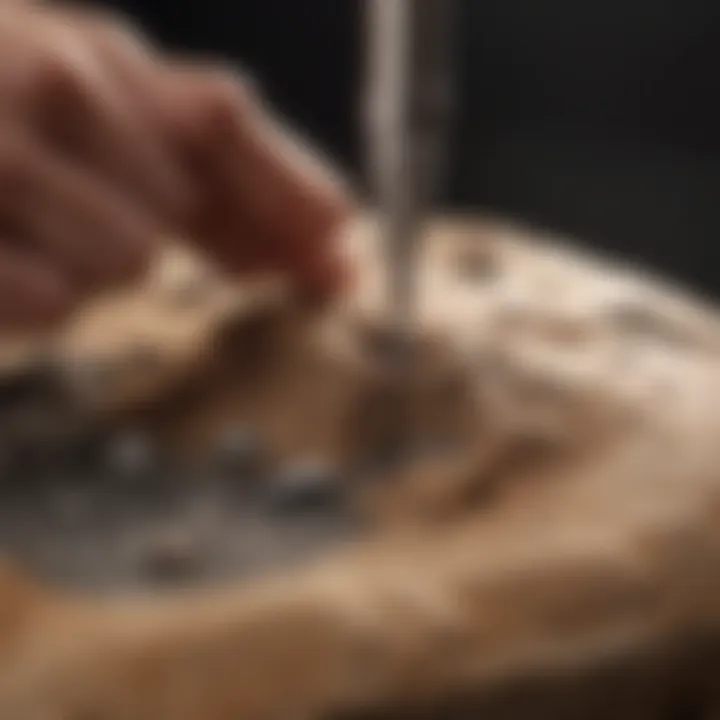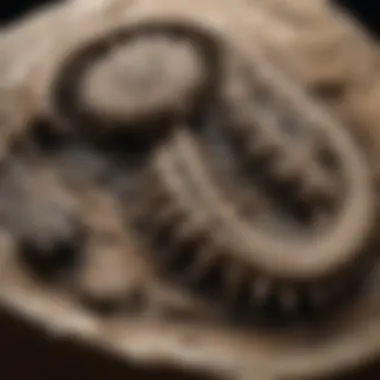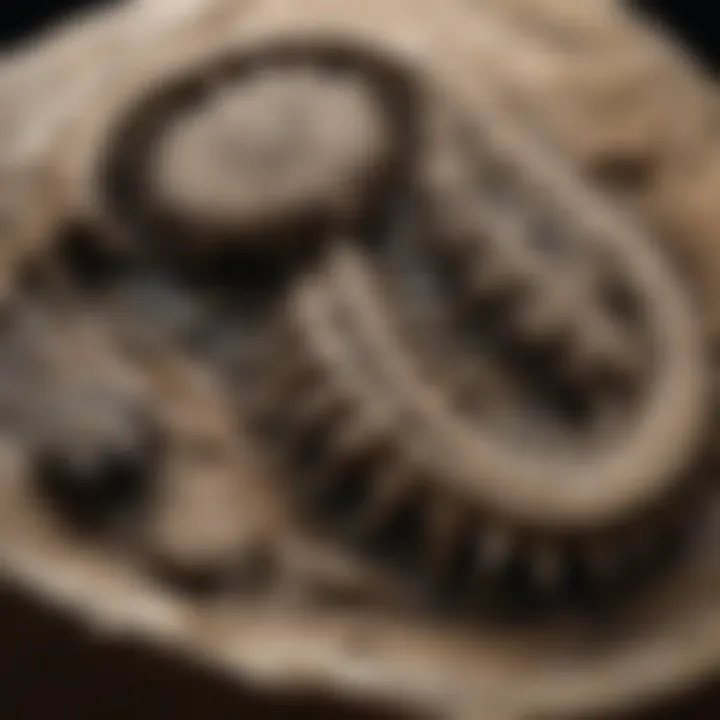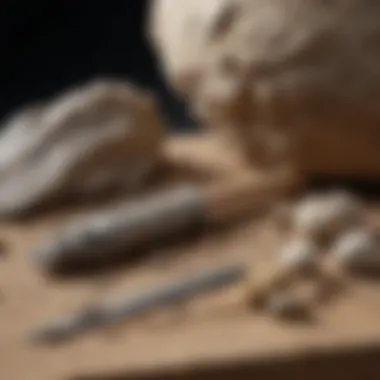Innovations in Paleontological Tooling: Air Scribers


Intro
The realm of paleontology continuously evolves with each technological advancement, significantly altering methodologies and outcomes in fossil preparation. Among these innovations, air scribers have emerged as a noteworthy tool, enhancing the efficiency and precision of fossil extraction. This article examines the various dimensions of air scribers, including their mechanisms, benefits, applications, and implications for both professional and amateur fossil collectors.
Featured Collectible of the Month
Overview
For fossil collectors, identifying and acquiring unique specimens is an essential part of the experience. This month, we spotlight an interesting fossil type: Diplodocus vertebra. The large and distinct vertebrae of the Diplodocus were known to be challenging to prepare using traditional methods due to their size and fragility. Workers would often damage or lose details while using picks and chisels. With the implementation of air scribers, collectors can acquire and prepare these fossils more efficiently.
Historical Significance
The Diplodocus is a titan among sauropods, living during the late Jurassic period. Fossils of this dinosaur have great scientific importance as they provide insights into the anatomy and environment of their time. The introduction of air scribers allows paleontologists to preserve these historical treasures with greater fidelity and less risk of damage.
Mechanisms of Air Scribers
Air scribers operate through a pneumatic system. They convert compressed air into rapid, precise movements. The tool's tip vibrates at high frequencies, allowing it to remove matrix material with minimal effort. This functionality is particularly crucial when working on delicate specimens that require accuracy and control.
Advantages Over Traditional Methods
The shift from manual tools to air scribers marks a significant improvement in fossil preparation. Here are some key advantages:
- Precision: Air scribers allow for more detailed work, preserving finer features in fossils.
- Speed: The speed of preparation increases, enabling paleontologists to process larger quantities of fossils in less time.
- Reduced Damage Risk: The controlled application minimizes the chance of inadvertently chipping or damaging delicate materials.
Applications in Paleontological Contexts
Air scribers serve a diverse array of applications. From extracting tiny, intricate fossils to preparing larger specimens, they have proven useful in various settings:
- Field Work: Useful for on-site preparation, allowing quick extraction of specimens while minimizing damage.
- Laboratory Settings: Ideal for further refining collected fossils, enabling detailed study and presentation.
Future Implications
As air scribers continue to develop, their potential impact on paleontological studies will become more profound. With ongoing advancements, we can expect improved designs that enhance usability and efficiency.
Furthermore, the accessibility of these tools enables not only professionals but also amateur collectors to engage deeply in fossil preparation, widening the scope of participation in paleontological research and discovery.
"The role of technology in fossil preparation is not just about efficiency; it is about preserving history for future generations."
Closure
Air scribers represent a significant turning point in fossil preparation techniques. Their implementation marks a shift towards greater precision and safety in the practice. By embracing these tools, paleontologists can ensure better preservation and understanding of fossils. With a wider array of applications and implications, the future of fossil studies looks promising, especially as more collectors recognize the advantages air scribers bring to their practices.
Prologue to Fossil Preparation
In paleontology, the process of fossil preparation is crucial. It involves the careful extraction and treatment of fossils from their surrounding matrix. Proper fossil preparation ensures that valuable scientific information can be preserved and studied. The choice of techniques used in fossil preparation can significantly influence the quality of the fossils and the insights that can be derived from them.
The Importance of Fossil Preparation
Fossil preparation plays a vital role in understanding the history of life on Earth. Well-prepared fossils allow researchers to conduct detailed studies, such as examining anatomical structures and dating the fossils accurately. Moreover, fossil preparation helps maintain the integrity of specimens for future research and education. Without proper techniques, fossils can be damaged or destroyed, losing irreplaceable data.
Fossil preparation is also essential for exhibiting fossils in museums or educational settings. Here, the visual appeal and authenticity of the fossils attract interest and promote public engagement with paleontology. By ensuring that fossils are prepared meticulously, curators can present the specimens in ways that highlight their significance and beauty.


Conventional Fossil Preparation Techniques
Traditional techniques for fossil preparation often involve mechanical tools, chisels, and hand tools to remove matrix material. Each method has its strengths and limitations. Some common conventional techniques include:
- Chiseling: This involves removing rock layers manually. It is labor-intensive and requires great skill to avoid damaging the fossil.
- Pick and Hammer: Used for larger, tougher samples. While effective, it can be quite aggressive, posing a risk to fragile specimens.
- Air Abrasion: Involves blasting air with small abrasive particles to remove unwanted material. This technique requires careful control to prevent damage.
While these conventional techniques can yield good results, they often lack the precision needed for delicate fossils. As techniques evolve, new innovations such as air scribers provide alternatives that enhance fossil preparation processes. Understanding these advancements is crucial for anyone involved in fossil preparation, from amateur collectors to professional paleontologists.
Understanding Air Scribers
In the realm of paleontology, tools are not merely instruments; they shape the very essence of how fossils are prepared and examined. Among these tools, air scribers have emerged as indispensable devices that greatly enhance the process of fossil preparation. Understanding air scribers encompasses a detailed look at their mechanisms, components, and implications on the workflow of both professionals and enthusiasts in the field. As fossil collectors aim to improve their techniques, the introduction of such innovative tooling becomes crucial for refining their craft.
Definition and Mechanism
Air scribers are pneumatic tools used primarily in the preparation and cleaning of fossils. They operate by using compressed air to drive a sharp, vibrating tip that effectively removes matrix material from fossils without damaging the specimen itself. This mechanism allows for precise control and fine-tuning, making them preferable for working on delicate structures that require a gently guided approach. The controlled vibration provides the ability to delicately excavate around fragile fossil edges, preventing unwanted breaks during the preparation process.
Furthermore, the ability to adjust the air pressure can modify the tool's forcefulness, allowing operators to tailor their approach based on the fragility of the material they are working with. This customizability is what sets air scribers apart from traditional tools, which often lack the flexibility required for delicate tasks.
Components of Air Scribers
To fully appreciate the function of air scribers, one must understand their components. Each air scriber consists of several key elements:
- Air Compressor: Supplies the pressurized air necessary for the operation of the tool. A reliable compressor is crucial for sustained use.
- Vibrating Tip: The part that directly interacts with the fossil material. It is often interchangeable, with various shapes available depending on the specific need of the task.
- Control Handle: Where the user holds the tool. This component often includes the trigger for activating the device and adjusting the air pressure.
- Hoses and Connectors: Facilitate the transfer of compressed air from the compressor to the scriber itself.
- Filter System: This maintains air quality and prevents contaminants from entering the fragile workspace.
In summary, air scribers represent a significant leap forward in fossil preparation technology. Understanding their mechanics and components provides collectors and specialists with the knowledge necessary to optimize their fossil preparation techniques and maintain the integrity of their specimens. The right tools can lead to more efficient workflows and better preservation of valuable fossils.
Applications of Air Scribers in Paleontology
Air scribers have become an essential tool in the realm of paleontology, significantly impacting fossil preparation. The precision and efficiency they offer are vital for both fieldwork and laboratory settings. Understanding the specific applications of air scribers can enhance the methods used in fossil extraction and study, ensuring better results and a lesser likelihood of damage. Moreover, with the rise of technology in various fields, it is crucial for collectors and researchers alike to adapt these innovations into their practices.
Field Use for Fossil Extraction
In the field, acquiring fossils often demands quick yet careful actions to avoid compromising the delicate structures being unearthed. Air scribers serve as effective instruments in this context. They enable paleontologists to work around the fossils with high precision, minimizing the impact on surrounding materials. This aspect is particularly crucial in instances where fossils are encased in hard rock or fragile sedimentary layers. By utilizing air scribers, researchers can extract fossils with greater accuracy, ensuring that the integrity of the fossil is maintained.
The use of air scribers also requires less manual effort compared to traditional tools like chisels and hammers. This reduction in strain can be significant during long excavation days. Moreover, air scribers can be effective in confined or awkward spaces where larger tools cannot reach, allowing for a more versatile approach to fossil extraction.
"The effectiveness of air scribers in field applications provides an unparalleled advantage, often resulting in a more complete and intact specimen."
Laboratory Use for Detailed Work
Once fossils are located and extracted, the next phase is often their preparation for study or display. In the laboratory, air scribers facilitate detailed work on fossil surfaces that require intricate handling. Their ability to target specific areas helps conserve more delicate parts of fossils while removing unwanted matrix material. This level of detail is key for paleontologists who aim to study particular structural attributes or forge casts for further research.
The versatility of air scribers also extends to various fossil types, from bone fragments to intricate shell structures. Given that no fossil is alike, the ability to adjust the tool's pressure and speed allows paleontologists to customize their approach as needed.
In addition, air scribers significantly reduce the time spent on fossil preparation. Because they are efficient in removing unwanted material without excessive manual intervention, precious hours can be saved. This increased efficiency results in a greater output of prepared fossils ready for study or display.
In summary, air scribers present a range of applications that not only improve the overall quality of fossil extraction and preparation but also encourage more thorough scientific inquiry. Integrating air scribers into fossil preparation processes can enhance research methodologies and outcomes.
Advantages of Air Scribers
The advancements in fossil preparation techniques have led to the increased usage of air scribers. These tools are not only innovative but also essential in improving the quality and efficiency of fossil preparation. Understanding the advantages they bring to the process is crucial for rock and fossil collectors who strive for precision and effectiveness in their work. Three significant benefits include enhanced precision during preparation, a reduction in the potential damage to fossils, and an overall increase in efficiency in workflow.


Enhanced Precision in Preparation
One of the most significant advantages of air scribers is the enhanced precision they offer. The design of these tools allows for fine control over the cutting and preparation process. Unlike conventional methods, air scribers can remove matrix material with surgical accuracy. This means that they can carve around delicate structures without affecting the fossil itself. Consequently, users can preserve intricate details of the specimen, which is vital for accurate scientific analysis and display purposes. Collectors are often focused on every detail, and having the ability to carefully work around fragile fossils greatly benefits their efforts.
Reduction in Fossil Damage
Another key benefit of using air scribers is the reduction in fossil damage during the preparation process. Traditional tools, such as chisels or hammers, can exert significant force which might inadvertently break or chip fossils. Air scribers, operating with air pressure, drastically lessen the chance of such damage. By minimizing the physical impact on the fossil, these tools preserve the integrity of specimens that are either rare or of significant scientific value. As a result, rock and fossil collectors can approach their work with more confidence, knowing they are less likely to compromise the quality of the fossils they handle.
Efficiency in Workflow
Efficiency is paramount in any preparatory work, especially within the field of paleontology. Air scribers offer a significant improvement in workflow. Their use reduces the time spent on intricate preparations and allows for faster progress on projects. This can be particularly advantageous in field settings, where timing is crucial. Furthermore, the tool's capabilities to quickly switch between different grits and styles of tips mean that users can adapt their approach based on the specific needs of each fossil. This versatility leads to a streamlined process overall, facilitating a smoother transition from field collection to laboratory analysis.
"The adoption of air scribers has fundamentally altered the pace and precision of fossil preparation strategies, allowing for a more refined approach to specimen handling." - Expert Paleontologist
Considerations for Using Air Scribers
Air scribers have pioneered new ways of fossil preparation. However, the adoption of these tools requires thoughtful consideration. Understanding how to use these tools safely and effectively can greatly enhance the fossil preparation process. This section outlines critical elements related to the safe and optimal usage of air scribers, ensuring that both fossils and users are well-protected.
Safety Precautions
Before embarking on fossil preparation with air scribers, it's essential to recognize the inherent risks involved. These tools can produce fine dust and debris while working. Protective gear should be a non-negotiable component of your toolkit. The following safety measures are recommended:
- Personal Protective Equipment (PPE): Always wear safety goggles to protect your eyes from flying particles. A dust mask or respirator is also advisable to avoid inhaling silica or other debris.
- Work Environment: Ensure adequate ventilation in your workspace. Working outdoors or in a well-ventilated area reduces dust accumulation.
- Tool Maintenance: Regularly check air scribers for any signs of wear and tear. Properly maintained tools reduce the risk of accidents.
It is crucial to create a safe working environment. Proper precautions not only preserve the integrity of the fossils but also safeguard personal health.
Training for Optimal Usage
Operating air scribers effectively requires skill and practice. Training is not merely beneficial, but essential for achieving the desired outcomes. Without appropriate training, the potential for damaging fossils or using the tools ineffectively increases. Here are some vital points to consider regarding training:
- Hands-on Experience: Participating in workshops or training sessions can provide invaluable practical knowledge. Many universities and paleontological institutions offer such courses.
- Understanding Tool Mechanics: Familiarize yourself with the mechanics of air scribers. Knowing how to adjust air pressure and choose the right tip is vital for precise work.
- Supervised Practice: Initially, practice under the guidance of an experienced operator. This mentorship helps develop technique and confidence.
"Training is a continuous process. Regularly updating skills can lead to noticeable improvements in fossil preparation outcomes."
Comparative Analysis of Air Scribers and Traditional Tools
The comparison between air scribers and traditional fossil preparation tools is significant for understanding their unique advantages and potential limitations. This analysis guides paleontologists and fossil collectors in making informed decisions regarding the tools they use. Through this examination, one can appreciate how air scribers have evolved as a leading option, enhancing various stages of fossil preparation.
Tool Performance Comparison
Air scribers excel in precision and efficiency compared to traditional tools. Traditional tools, such as chisels and hand tools, rely heavily on the skill of the operator, introducing variability in results. In contrast, air scribers utilize a pneumatic system that delivers controlled bursts of air or vibrations. This technology allows for more accurate detailing around fragile fossils, which is often critical in preserving delicate structures.
Moreover, the reduced physical effort needed when using air scribers plays a pivotal role in prolonged work sessions. Fossil preparation often requires hours of meticulous effort, and traditional tools can lead to fatigue, affecting overall performance. Air scribers mitigate this issue, allowing users to focus on technique rather than exertion.
In terms of time efficiency, air scribers facilitate faster preparation. Fossils can be readied for study, display, or conservation with fewer passes compared to traditional methods. This expedited process is particularly beneficial during field work, where time may be limited. It is crucial, however, to recognize that both tool types have their unique use cases, with traditional tools still relevant in certain contexts, particularly where detailed manual touch is required.
Cost-Benefit Analysis
The financial implications of choosing air scribers over traditional tools must also be addressed. Although air scribers typically represent a higher upfront cost due to their advanced technology, the long-term benefits can outweigh this initial investment. The efficiency gained through air scribers can result in quicker project completions, translating into cost savings on labor and materials.
Additionally, the reduction in fossil damage when using air scribers can also have economic benefits. Damaged fossils may require costly repairs or could decrease their value if they are collectors’ items. Thus, a better-preserved fossil not only maintains its intrinsic worth but can also enhance the overall yield from collection or study efforts.


Another consideration in this analysis is maintenance and operational costs. Air scribers require regular maintenance to ensure optimal performance. However, the quality and durability of air scribers mean that, with proper care, they can last for a long time. Traditional tools, while usually less costly upfront, may need to be replaced more frequently or require more frequent sharpening or repair.
Case Studies in Fossil Preparation
Case studies provide crucial insights into the practical applications and efficacy of air scribers in fossil preparation. They showcase real-world experiences from paleontologists and fossil collectors. Through these examples, we can analyze specific elements such as the tools' performance, advantages, and the systematic approach to fossil preparation.
The benefits of examining case studies include a deeper understanding of how air scribers improve the fossil preparation process. They highlight innovative practices and measurable outcomes. Furthermore, they allow for evaluation of the strategies employed when utilizing these tools, both in the field and the laboratory.
Successful Applications of Air Scribers
In various expeditions, paleontologists have documented the successful utilization of air scribers. One notable application occurred during the excavation of a dinosaur skeleton in the late Jurassic period. The researchers employed air scribers to carefully remove sediment while preserving delicate bone structures. This method not only enhanced precision but also significantly reduced the risk of damaging fragile fossils.
In another case, a team prepared a well-preserved Brachiosaurus vertebra. The use of air scribers allowed them to meticulously clear matrix material, retaining the integrity of the fossil. The detailed process underscored how these tools facilitate intricate work that traditional methods struggled to achieve, especially in complex or crowded fossil sites.
"Air scribers have become indispensable in my excavations. The control they offer makes all the difference in preserving these ancient treasures."
— Experienced paleontologist
Other applications involved laboratory settings where air scribers aided in reconstructing fragmented fossils, particularly in areas with significant wear and abrasion. The speed and versatility of air scribers streamlined complex restorations, leading to high-quality reconstructions and augmenting the research potential of each find.
Challenges Encountered
Despite their advantages, the deployment of air scribers is not without challenges. One significant concern is the learning curve associated with using the tool effectively. New users may struggle to achieve the necessary finesse in handling the scriber. Proper training becomes essential to prevent accidental damage to fossils during preparation.
Another challenge arises from the tool's reliance on compressed air. Supply issues can complicate fieldwork. A lack of access to a reliable air compressor can hinder fossil preparation efforts, especially in remote locations. Furthermore, different sediment compositions can affect the performance of air scribers, sometimes requiring adjustments in technique or even alternative tools.
The cost of air scribers presents another hurdle for some amateur collectors. While they work effectively, the initial investment may be significant compared to traditional methods. This raises questions about accessibility for less experienced fossil enthusiasts.
Future Directions in Fossil Preparation Technology
The field of fossil preparation is at a transformative juncture. Embracing new technologies can redefine how fossils are extracted, preserved, and studied. The future of fossil preparation technology is vital, as it determines how paleontologists can improve their methods for a clearer understanding of Earth's biological history. With advancements in tools like air scribers, the focus shifts towards precision, safety, and efficiency. This section outlines innovations on the horizon and analyzes how interdisciplinary research can shape future practices in paleontology.
Innovations on the Horizon
Innovations in fossil preparation technology promise better outcomes for both researchers and collectors. For instance, the integration of digital imaging can allow paleontologists to visualize fossils in three dimensions before even touching the specimen. 3D models can reduce the potential for damage, as they provide insight into what lies beneath the surface of the rock or sediment.
Additionally, automated tools are being developed to assist in the fossil preparation process. Robots equipped with air scribers could perform some of the more monotonous tasks. This advancement not only speeds up the preparation but also allows skilled paleontologists to focus on more intricate aspects of the work. Also, new materials for air scribers are emerging, leading to longer-lasting tools that can operate effectively under a variety of conditions.
It is worth noting the potential for augmented reality (AR) in training new paleontologists. AR can provide a hands-on learning experience without direct consequences for delicate fossils. Trainees will learn to operate air scribers effectively while interacting with digital fossil models.
Interdisciplinary Approaches in Paleontological Research
The integration of multiple disciplines stands as a cornerstone for future advancements. Collaboration between paleontologists, materials scientists, engineers, and computer scientists can yield innovative solutions. Materials science can introduce advanced composites for tool construction, enhancing both durability and functionality.
Incorporating insights from engineering can optimize tool designs, ensuring tools like air scribers are not only effective but also ergonomic. Furthermore, collaboration with computer scientists can provide better data management and analysis tools, enhancing the workflow in fossil preparation labs.
Understanding the environmental impact of tools used in fossil preparation is another area that requires attention. Researchers across disciplines can collaborate to develop eco-friendly practices, ensuring that the advancement of technology does not compromise environmental integrity.
The innovation landscape shows promise, but it requires ongoing dialogue among diverse academic fields. With an interdisciplinary approach, the potential for breakthroughs in fossil preparation methods becomes more tangible, pushing the boundaries of paleontological research forward.
Ending
The conclusion serves as a crucial component of this article, consolidating various insights and implications surrounding the role of air scribers in fossil preparation. It underscores the importance of understanding how technological innovations can enhance both the efficiency and efficacy of fossil preservation techniques. The significance of adopting air scribers lies not just in their advanced capabilities but also in transforming the overall approach to fossil preparation.
Summary of Key Insights
In this discourse, several key points emerge regarding air scribers. Firstly, these tools facilitate unprecedented precision, minimizing damage to fossils and allowing for intricate work on delicate specimens. Furthermore, air scribers improve workflow efficiency, reducing the time needed to prepare fossils while increasing the quality of outcomes. The detailed analysis reveals that not only do air scribers surpass traditional methods in performance, but they also embody a necessary evolution in paleontological practices. As the fossil preparation field progresses, understanding the mechanics and applications of air scribers can lead to enhanced results and better-preserved specimens.
Encouragement for Evolution in Techniques
Looking ahead, there is an evident need for the paleontological community to adopt these innovative tools. Encouragement stems from recognizing the potential for air scribers to facilitate greater accuracy and less invasive techniques in fossil preparation. Training and education on the optimal use of air scribers can empower researchers and fossil collectors alike to embrace these advancements. Transitioning from traditional methods to air scribers should not just be seen as a simple upgrade but as a significant leap toward modernizing fossil preparation. To sustain growth and innovation in this field, it becomes vital to embrace these changes and fuel an ongoing evolution in techniques and methodologies.



